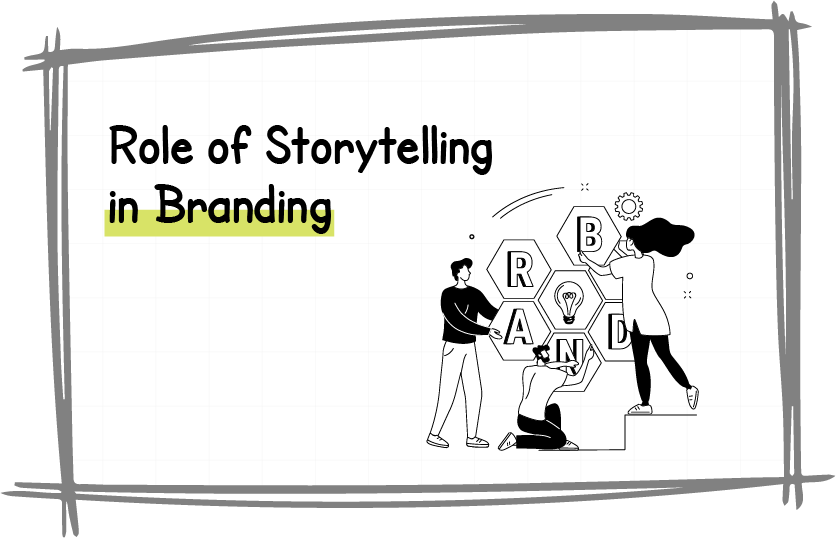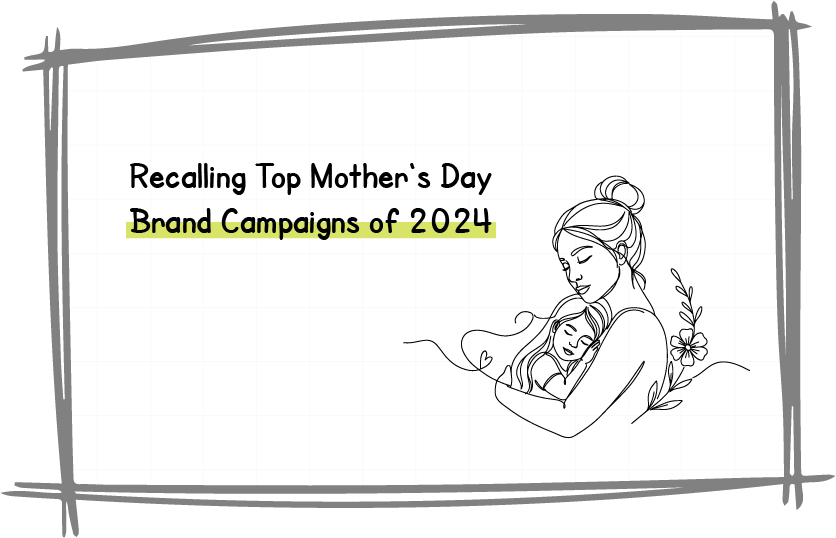Table of Content
- What is Brand Storytelling?
- Why Storytelling Matters in Branding?
- Types of Storytelling in Branding
- Examples of Effective Brand Storytelling
- Implementing Storytelling in Branding Strategy
- Role of Digital Platforms in Storytelling
- Conclusion
- FAQs
Storytelling in branding transforms mundane interactions into memorable experiences. Imagine waking up on a Monday, sipping coffee, and scrolling through your inbox. You see the same pitches, the same templates; nothing that grabs you. This is where brand storytelling changes the game. It turns generic updates into narratives that stick.
Take a coffee shop visit as an example. As you step inside, the aroma of freshly brewed coffee envelops you. Handwritten quotes on the walls, portraits of farmers, and a barista who remembers your order, all these details weave a story. This isn’t just about selling coffee; it’s about creating connections, evoking feelings, and building loyalty.
At its heart, brand storytelling is about crafting moments that resonate deeply. By tapping into shared emotions and experiences, brands shift from transactional relationships to meaningful ones. They become partners in their audience’s journey, not just providers of products or services.
This blog explores how storytelling in branding builds emotional connections, drives loyalty, and helps your brand stand out.
What is Brand Storytelling?

Brand storytelling is all about crafting a narrative that resonates with your audience, allowing them to connect emotionally with the brand. Clearly, understanding what your brand represents serves as the foundation for developing an effective storytelling strategy and defining your goals.
Storytelling enables customers to form personal connections with your brand by raising strong emotional responses.
Integrating storytelling techniques into your marketing efforts allows you to effectively convey your core values, brand personality, and unique selling propositions.
Executing your brand story perfectly helps your business stand out by presenting your message authentically and engagingly. The ultimate objective is to foster deeper connections with your audience and build stronger brand loyalty.
In the end, sharing consistent, relatable, and inspiring stories builds lasting relationships with your customers. For businesses, brand storytelling in marketing showcases brand values and aligns them with customer expectations. It not only boosts the brand's identity but also differentiates you in a crowded market, boosts engagement and retention, and elevates your reputation.
Why Storytelling Matters in Branding?
As humans, we tend to form a strong connection, especially with things that resonate with us on an emotional level, sometimes without even knowing why. This could be a nostalgic memory or a satisfying resolution to a challenge we faced. These emotional connections are what build ever-lasting bonds.
In brand storytelling, your brand identity, design and content should consistently stimulate positive associations. The marketing team must craft strategies to achieve this. To successfully craft a winning strategy, you must first understand their audience: what they desire, what they need, and the challenges that weigh on their minds.
Leverage customer data to gain insights and create stories and experiences that genuinely connect rather than focusing solely on driving sales.
A marketing approach built around compelling stories and meaningful customer experiences is far more likely to foster lasting brand loyalty and trust over time.
Elements of a Good Brand Story
Relatability
One of the elements of branding is relatability, which involves helping your audience see themselves in your narrative. Create stories that connect with your audience's needs, desires, and experiences through your brand.
When consumers bond with your brand on a personal level, they tend to build an emotional connection. To achieve this, consider your target audience's demographics, psychographics, and behaviours.
Craft stories that reflect their experiences, aspirations, and challenges.
Authenticity
You might not know, but your potential customers can spot fake content from a distance.
To impress your customers and gain their trust, your story should be genuine, reflecting your brand's values, mission, and vision.
Modern consumers are savvy, they can spot inauthentic content instantly. Which can break their trust and harm your brand's reputation.
By being honest and transparent in your storytelling, you can build credibility and foster a stronger connection with your audience. For example, sharing the challenges your brand faced and how you've overcome them can make your story more relatable and inspiring.
Emotional Connection
Connecting with emotions that bond with your target audience can boost your brand's message and leave a lasting impression.
Whether it's joy, inspiration, empathy, or nostalgia, your story should express feelings that align with your brand's identity and values. This emotional bonding makes your story memorable and inspires your audience to act, be it by making a purchase, sharing your content, or becoming a loyal brand advocate.
Consistency
Your brand story must remain consistent across all platforms and touchpoints, including social media, your website, online ads, and more. Brand consistency reinforces your brand's identity and ensures your audience receives a unified message, no matter how or where they engage with your brand.
Consistent messaging builds trust and strengthens your brand’s presence in consumers’ minds.
Simplicity
In today's information-overloaded world, simplicity is essential. Your brand's story should be clear, concise, and easy to understand.
Don't use unclear jargon or unnecessary details that could weaken your message. Keep your approach straightforward and narrative-focused, as it is proven to connect, be remembered, and be shared.
To keep it simple, centre your story around a compelling message that captures the essence of your brand.
Types of Storytelling in Branding
Storytelling is a powerful way to forge lasting emotional connections with your audience. Here are four effective types of storytelling in marketing.
Product Stories
Product stories in branding go beyond just listing features; they typically focus on showcasing how a product solves real-world problems for its target audience.
These stories often delve into the inspiration behind the product's creation or highlight how it addresses specific challenges.
Brand Stories
Brand stories are more than just a timeline of events; they are the heart and soul of a brand, capturing its purpose, values, and the journey that defines its identity.
A compelling brand story resonates with audiences by showcasing authenticity, connecting on an emotional level, and demonstrating how the brand solves real-world challenges.
Whether highlighting humble beginnings, a mission to create change, or a commitment to innovation, a well-crafted brand story builds trust and loyalty, turning customers into advocates. It's not just about what the brand sells; it's about why it exists and the impact it seeks to make.
Customer Stories
Another type of storytelling is customer stories, which are powerful narratives that highlight real-time experiences of individuals or businesses benefiting from a product or service.
These stories go beyond testimonials by showcasing relatable challenges, the solutions provided, and the tangible impact made. They build trust and emotional connections by illustrating the value delivered in a meaningful context.
By focusing on the customer's journey, these stories humanize the brand and inspire others, creating a deeper connection with potential clients.
Social Impact Stories
Last but not least is the social impact stories that bring to life the transformative power of collective action, showcasing how individuals, communities, or organizations drive meaningful change.
These stories highlight real-life challenges and the innovative solutions that address them, inspiring others to take action.
Whether it's empowering underserved communities, promoting sustainability, or advancing education, social impact stories illustrate the ripple effect of compassion and determination. They remind audiences that small steps lead to progress and motivate them to contribute to a better, more equitable world.
Examples of Effective Brand Storytelling
Nike

Nike's brand story is a compelling call to action, celebrating athletes who push boundaries and overcome obstacles.
Embodied by the iconic slogan "Just Do It", it's a narrative of determination and personal triumph.
Nike's storytelling goes beyond promoting products; it inspires people to chase their dreams and embrace the spirit of sports and fitness. Their ads often feature real athletes and authentic stories of perseverance, creating a deep emotional connection with consumers. Nike's story exemplifies the power of motivation and aspiration.
Apple

Apple hardly needs an introduction. The brand has become a global icon renowned for its innovation, simplicity, and design excellence. Co-founder Steve Jobs, a visionary storyteller, captivated audiences with his charismatic product launches and engaging narratives.
Apple's brand centres on empowering individuals to 'think differently' and challenge conventions. With its unwavering commitment to innovation and exceptional design, Apple stands as a true leader in brand storytelling.
Snickers

Snickers' brilliant 'you're not you when you're hungry' tagline perfectly uses witty and relatable hunger-induced mood swings to connect with audiences.
Featuring celebrities in hilarious, out-of-character situations, the campaign cleverly highlights how a Snicker bar can tame both hunger and 'hungry' moments.
Implementing Storytelling in Branding Strategy
Stories are not something that you share; the audience experiences them. Great storytellers prioritize their listeners. To integrate brand storytelling in marketing effectively, follow these steps:
Define your brand's core values and mission: Knowing what your brand represents and aims to accomplish will shape the stories you tell.
Know your audience: Research your target audience's demographics, preferences, pain points, and aspirations. Personalize your stories to connect with these insights, ensuring they bond with your customers' lives and experiences and not just your brand.
Build authentic and relatable stories: Express authentic stories that reflect your brand's value and mission, such as your journey, challenges, customer successes, or impact.
Use multiple channels of storytelling: Social media, blogs, videos, podcasts, native ads, and email campaigns are all powerful storytelling tools. All these platforms provide different ways to connect with the audience, from visual storytelling to detailed narratives on your blog or customer testimonials.
Make your brand story the foundation of your marketing: Your brand's story should be the consistent foundation of all your marketing efforts. From product launches to social media content and ads, a unified narrative strengthens your brand identity and creates a cohesive image over time.
Role of Digital Platforms in Storytelling
Digital platforms play an essential role in modern storytelling by offering various ways to engage and connect with audiences.
From social media to blogs, podcasts, and videos, these platforms allow brands to share their stories in real time, reaching global audiences instantly. They enable interactive and immersive experiences, making storytelling more personalized and dynamic.
By utilizing digital tools, brands can build stronger connections, foster engagement, and continuously evolve their narrative to stay relevant in today's fast-paced world.
Conclusion
In short, branding and storytelling go hand in hand. A strong brand story helps you connect emotionally with your audience and build lasting relationships.
Whether it’s about your products, customers, or impact, storytelling forms the foundation of effective marketing. Sharing these stories across platforms boosts reach, engagement, and relevance.
At Brand Board Media, a leading branding agency in Ahmedabad, we help businesses craft authentic stories that build trust, inspire loyalty, and elevate their brand experience. Get in touch with us. Contact us, or call us on +917874072801
FAQs
The pillars of brand storytelling include relatability, authenticity, emotional connection, consistency, and simplicity. These elements work together to create a compelling and memorable brand story.
Brand storytelling is vital because it helps create emotional connections with your audience, builds trust, and strengthens brand loyalty.
Brands should use storytelling in marketing by creating authentic, relatable narratives that connect emotionally with their audience. By focusing on the brand's values, mission, and customer experiences, stories can engage consumers, build trust, and foster loyalty.
The four C's of storytelling are:
- Character
- Conflict
- Climax
- Conclusion



